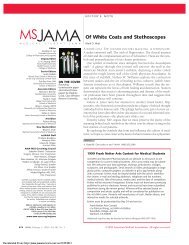SPECIALISTS AND SERVICES FOR THIS AUCTION
NYR14319_SaleCat
NYR14319_SaleCat
Create successful ePaper yourself
Turn your PDF publications into a flip-book with our unique Google optimized e-Paper software.
Fig. 2. Longquan Vase, Ming dynasty. PDF. 238. © Sir<br />
Percival David Collection/courtesy the Trustees of The<br />
British Museum.<br />
圖 二 明 景 泰 五 年 (1454 年 ) 龍 泉 青 釉 刻 纏 枝 花 卉 紋 鳳 尾<br />
尊 大 維 德 爵 士 舊 藏<br />
Fig. 3. Longquan vase, Ming dynasty, National Palace<br />
Museum, Taipei, After Green – Longquan Celadon of the<br />
Ming Dynasty, Tsai Mei-fen (ed.), Taipei, 2009, pp. 158-9,<br />
no. 81 and front cover.<br />
圖 三 明 龍 泉 青 釉 刻 纏 枝 花 卉 紋 鳳 尾 尊 國 立 故 宮 博 物 院 藏<br />
There is a very similar vase of the same height in the collection of Sir Percival David, London (see<br />
Illustrated Catalogue of Celadon Wares in the Percival David Foundation of Chinese Art, London, 1997,<br />
p.35, no.238). (Fig. 2) The Percival David vase shares the same decorative scheme as the Fujita vase,<br />
including the protruding line at the junction of lower body and shoulder, and also the two relief lines<br />
around the foot. On the neck of the David collection vase is a panel with an open lotus blossom at the<br />
bottom and a lotus leaf at the top, which contains an inscription incised under the glaze. This reads:<br />
景 泰 伍 年 福 里 鎮 安 社 信 人 楊 宗 信 喜 捨 恭 入 本 寺 供 養 □ 自 身 延 壽 者<br />
‘In the ffth year of the Jingtai period [AD 1454], the believer Yang Zongxin of the village of Zhen’an in<br />
the district of Fuli respectfully ofers this [vase] to the local temple to be placed before the Buddha,<br />
with a prayer for long life.’<br />
The National Palace Museum, Taipei has in its collection another vase which is very similar to the<br />
Fujita and David collection vases. (Fig. 3) It too has a related protruding join line at the lower edge<br />
of the shoulder, and also a double band at the foot (see 主 編 蔡 玫 芬 , 碧 緑 : 明 代 龍 泉 窯 青 瓷 /Green –<br />
Longquan Celadon of the Ming Dynasty, Tsai Mei-fen (ed.), Taipei, 2009, pp. 158-9, no. 81 and front<br />
cover). The Taipei vase is slightly smaller than the Fujita vessel, and has been dated by the Museum to<br />
1435-1460. It seems reasonable to assume that the Fujita Ming dynasty Longquan vase also dates to<br />
the mid-15th century.<br />
The Longquanxian zhi ( 龍 泉 縣 志 ) (Gazetteer of Longquan County) noted that:<br />
成 治 以 後 , 質 粗 色 惡 , 難 充 雅 玩 矣<br />
‘After the Cheng[hua] and [Hong]zhi reigns [AD 1465-1506], the form [of Longquan wares] became so<br />
crude and the colour so unappealing, that they were no longer ft for those of elegant tastes.’<br />
The Fujita Ming vase, therefore, represents the last great period of Longquan celadon production,<br />
when vessels of impressive form and glaze were still made at these prestigious kilns for the court and<br />
other members of the elite.<br />
Rosemary Scott<br />
International Academic Director, Asian Art<br />
39



